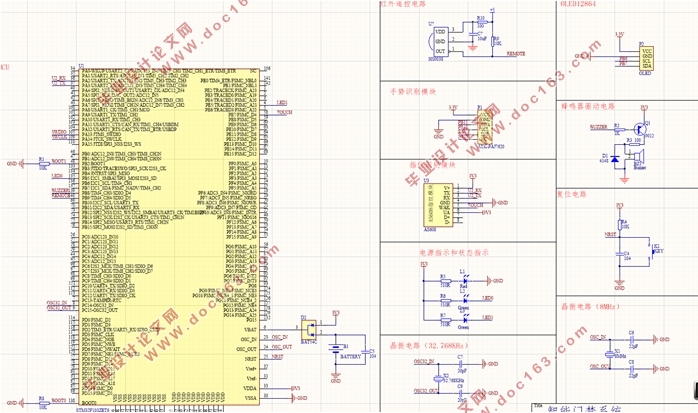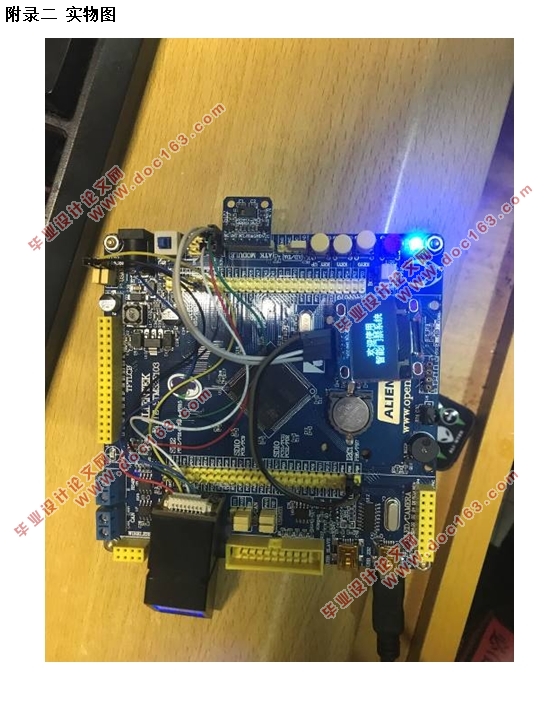基于STM32单片机的智能电子锁设计(附电路原理图,实物图)

1.无需注册登录,支付后按照提示操作即可获取该资料.
2.资料以网页介绍的为准,下载后不会有水印.资料仅供学习参考之用.
密 惠 保
基于STM32单片机的智能电子锁设计(附电路原理图,实物图)(任务书,开题报告,论文14000字)
摘要
本课题设计一个基于STM32的智能电子锁,该设计可以通过手势识别和指纹识别实现开锁。手势识别模块检测输入手势是否是程序预设的手势组合,若按顺序输入向上,向下,向左的手势组合,或者向右,向前,向后的手势组合,则识别成功;指纹识别模块检测输入指纹是否存在于指纹库中,倘若检测到的指纹与指纹库中的任一指纹模板匹配成功则识别成功。系统还可以实现指纹的录入、指纹的删除功能,其中删除指纹可以实现删除指定指纹号的指纹,并用OLED12864进行显示相关操作步骤。当录入和识别指纹时,OLED12864上会显示对应的指纹编号及相关提示信息。倘若手势识别或者指纹识别成功,则指示灯闪烁,蜂鸣器短暂鸣响,表示开锁成功,人员可以进入;否则指示灯不亮,蜂鸣器无反应,则表示开锁失败,人员不可以进入。
关键词:电子锁 STM32 指纹识别 手势识别
Design of Intelligent Electronic Lock Based on STM32
Abstract
This paper designs an intelligent electronic lock based on STM32 MCU, which can be unlocked by gesture recognition and fingerprint recognition. The gesture recognition module detects whether the input gesture is the preset combination of gestures in the program. If the input gesture combination is upward, downward, left, or right, forward and backward, the recognition is successful. Fingerprint identification module detects whether input fingerprints exist in fingerprint database. If the input fingerprint matches successfully with any fingerprint template in the fingerprint database, the recognition is successful. The system can also realize the function of fingerprint input and deletion, in which deletion of fingerprint can delete fingerprint with specified fingerprint number, and display related operation steps with OLED12864.When the fingerprint is input and identified, the corresponding fingerprint number and relevant prompt information will be displayed on the OLED12864 . If the gesture recognition or fingerprint recognition is successful, the indicator flashes and the buzzer sounds briefly, indicating that the lock is successfully unlocked and the person can enter; otherwise, if the indicator does not turn on and the buzzer does not respond, the lock is failed and the person cannot enter.
Key words: Electronic lock; STM32; Gesture recognition; Fingerprint recognition


目 录
摘要 I
Abstract II
第一章 绪论 1
1.1 选题背景 1
1.2 研究现状 1
1.3 本文的内容安排 4
第二章 系统总体方案设计 6
2.1 设计任务要求 6
2.2 系统设计思路和模块的选择 6
2.3 系统总体框架 7
2.4小结 7
第三章 系统硬件设计与实现 9 [来源:http://think58.com]
3.1 单片机最小系统 9
3.2 指纹识别模块 10
3.3 手势识别模块 14
3.4 OLED显示模块 16
3.5 红外遥控器模块 17
3.6蜂鸣器模块 18
3.7 指示灯模块 18
3.8 小结 19
第四章 系统软件设计与实现 20
4.1 软件设计总体思路 20
4.2 指纹识别模块程序设计 21
4.3 手势识别模块程序设计 23
4.4 OLED显示软件设计 27
4.5 红外遥控器软件设计 29
4.5 小结 31
第五章 系统调试与测试结果 32
5.1 OLED模块调试 32
5.2 红外遥控器模块调试 32
5.3 指纹模块调试 33
5.4 手势识别模块测试 35
5.4 测试结果 36
5.5 小结 36
第六章 总结与展望 37 [资料来源:www.THINK58.com]
6.1 小结与思考 37
6.2 工作展望 37
参考文献 38
致谢 40
附录一 电路原理图 41
附录二 实物图 42
[资料来源:http://THINK58.com]
